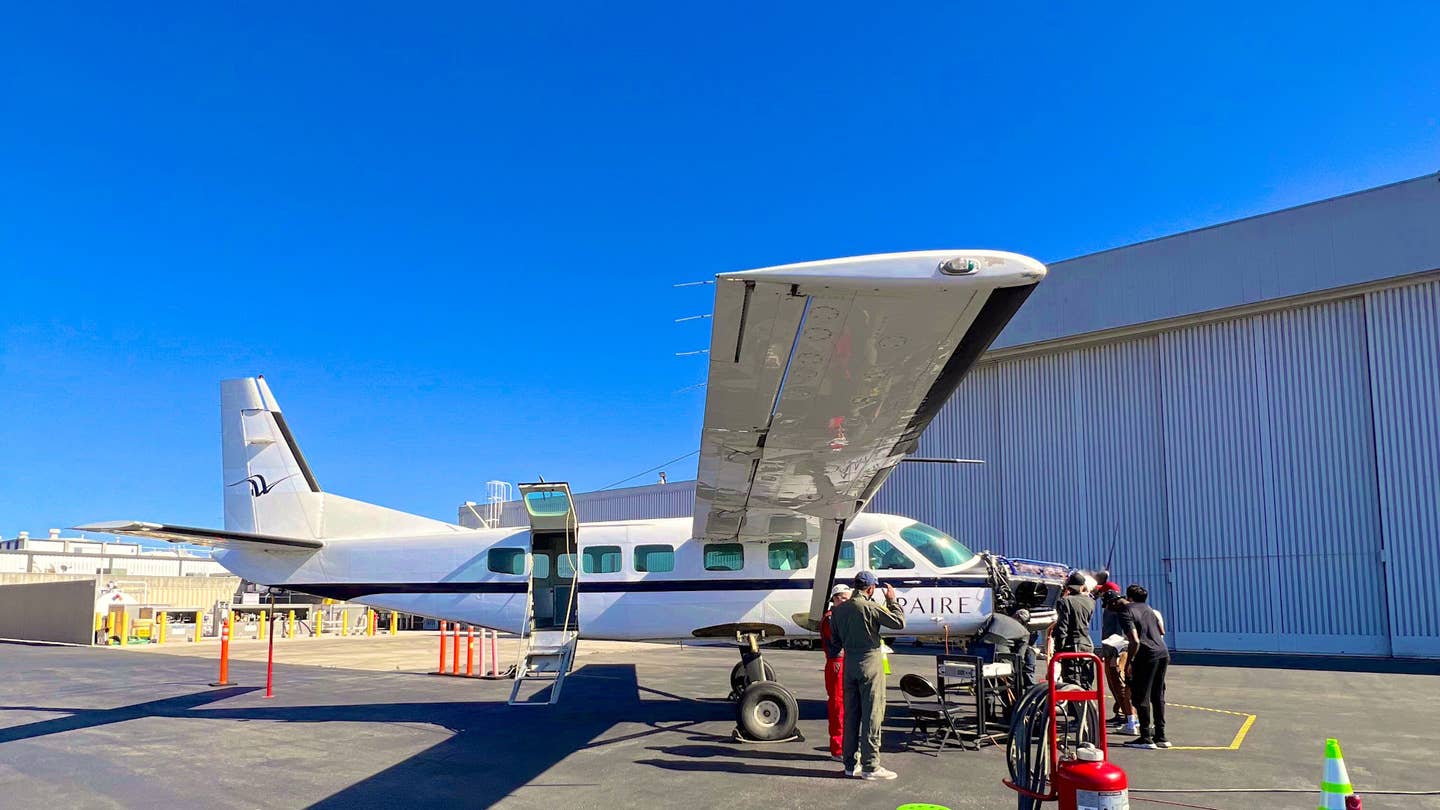Ampaire Completes Hybrid-Electric Ground Test Using Pure SAF
The company flew its hybrid-electric Eco Caravan using 100 percent ASTM D7566 SAF produced by partner Dimensional Energy.

Ampaire’s nine-seat Eco Caravan runs on a proprietary hybrid-electric propulsion system. [Courtesy: Ampaire]
Ampaire, the company that set the endurance record for hybrid-electric flight in December, believes it can become even more efficient.
The firm on Thursday announced it successfully completed a hybrid-electric ground test using sustainable aviation fuel (SAF) from partner Dimensional Energy. The pure, 100 percent ASTM D7566 SAF is produced from electricity and carbon dioxide and was used to fuel Ampaire’s nine-seat Eco Caravan, a modified Cessna 208B Grand Caravan.
The goal of testing was to validate the performance of Dimensional Energy’s pure e-fuel SAF. According to Ampaire, the results “exceeded expectations,” demonstrating a massive increase in energy efficiency compared to traditional jet fuels.
Both Ampaire and Dimensional Energy received funding and support from climate technology investor Elemental Excelerator. According to Ampaire, the investment has helped the partners more than double the efficiency of SAF consumption while driving emissions to near zero.
“By showcasing the transformative efficiency gains achievable through hybrid-electric propulsion, we are driving the future of eco-friendly air travel,” said Kevin Noertker, CEO of Ampaire. “For those already recognizing the potential of SAF, its integration into our hybrid-electric aircraft enhances its appeal even further.”
Ampaire’s Eco Caravan is a hybrid-electric design with a range of 1,100 sm (956 nm) and a payload of 2,500 pounds. In 2022, the manufacturer said the model could be the first electric regional aircraft to fly commercially. Ampaire expects FAA certification this year.
The aircraft is equipped with Ampaire’s proprietary AMP-H570 AMP Drive hybrid-electric propulsion unit. According to the company, the system will reduce fuel consumption and emissions by 50 to 70 percent compared to conventional Pratt & Whitney PT6 engines, which are common on Cessna Caravan turboprops.
Ground tests paired the hybrid-electric propulsion system with Dimensional Energy e-fuels to “reimagine” 100 percent electric flight and address SAF quality and cost concerns, the goal being to enable broader use. According to Ampaire, Dimensional Energy has two projects that will “add significant inventory to the world’s availability of e-fuels.”
“Technology providers have to collaborate beyond innovation and into execution,” said Jason Salfi, CEO of Dimensional Energy. “By combining Dimensional Energy e-fuels with Ampaire’s aircraft technology that can reduce the amount of fuels combusted during flight, we quicken the pace up the steep curve of the energy transition and reduce the need for extraction faster.”
Nonprofit investor Elemental Excelerator provided both Ampaire and Dimensional Energy with project development capital and years of support to scale the companies’ tech. The three partners intend to continue their collaboration and research into sustainable flight.
“[Ampaire and Dimensional Energy’s] innovations reduce pollution and noise in neighborhoods around airports and make possible a cleaner way to fly,” said Dawn Lippert, CEO of Elemental Excelerator.
Ampaire’s recent ground test wasn’t the company’s only milestone in the past few months. In fact, it doesn’t even come close to the firm’s biggest achievement: a 12-hour, 1,375 sm (1,195 nm) flight of its Electric EEL demonstrator. The flight set a high-water mark for hybrid-electric aircraft endurance, eclipsing the company’s previous record.
The EEL is a modified Cessna 337 Skymaster, also equipped with the AMP-H570 AMP Drive, that functions primarily as a testbed aircraft but could also serve owner-flown, charter, and short-haul regional airlines and carriers. It has a 400 sm (348 nm) range and 450-pound payload.
In 2020, Ampaire and the EEL also completed the first trial of a hybrid-electric aircraft along an actual airline route, in partnership with Hawaii’s Mokulele Airlines. The Eco Caravan, meanwhile, made its maiden voyage in 2022.
Ampaire’s largest order for the hybrid-electric design comes from U.K.-based lessor Monte Aircraft, which agreed to order up to 50 Eco Caravans. The firm also has an agreement with Azul Conecta—a subsidiary of Azul, Brazil’s largest airline by passenger volume—to convert six Grand Caravans in its fleet.
Meanwhile, Ampaire is working with NASA on several projects, most notably one that would install its propulsion system aboard a Twin Otter DHC6. It has an agreement with private charter operator WingTips for the conversion of 50 Twin Otters to Eco Otters—another Ampaire concept—in addition to 20 Caravans.
Unsurprisingly, major airlines and manufacturers are ramping up development of SAF as Ampaire matures its tech. Both Gulfstream Aerospace and Virgin Atlantic completed inaugural transatlantic flights fueled entirely by SAF in November. Rolls-Royce that month said all of its current engines can now run on 100 percent SAF.
According to the International Air Transport Association (IATA), SAF production tripled from 2021 to 2022. And with aviation industry groups working to speed its adoption, the dawn of SAF appears to be on the horizon.
Like this story? We think you'll also like the Future of FLYING newsletter sent every Thursday afternoon. Sign up now.

Sign-up for newsletters & special offers!
Get the latest FLYING stories & special offers delivered directly to your inbox






